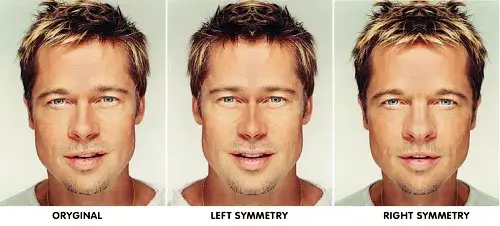Human Asymmetry. The world around us seems to adore symmetry. Snowflakes, butterfly wings, and leaves often captivate us with their perfect mirror-like patterns.
But one look in the mirror is enough to reveal a different story humans are far from symmetrical. One eyebrow sits slightly higher, the nose might lean a bit to the side, and even a smile is rarely perfectly even.
Human Asymmetry, fact.
While the external asymmetries between the left and right sides of our body are often subtle, inside, it’s a different story true organized chaos reigns.
The heart is shifted to the left, the liver dominates the right, and the lungs have a different number of lobes. But why is our body built this way?
Let’s explore…
It All Begins at the Molecular Level.
Proteins, DNA, sugars these fundamental “building blocks of life” are inherently asymmetric. This asymmetry is passed down to cells, tissues, and entire organs.
For example, nearly all amino acids in living organisms take a “left-handed” (L-form) shape, while sugars tend to be “right-handed” (D-form).
Put simply, in amino acids, the nitrogen-containing side group usually sits to the left of the central atom, while in sugars, the oxygen-containing group is typically on the right.
This phenomenon is called chirality a property that makes molecules and their mirror images similar yet non-identical, much like a left and a right glove.
This left-right orientation guides cellular processes and plays a crucial role in breaking the embryo’s symmetry around the third week of development.
The Embryo’s First Twist.
It starts in a tiny structure known as the embryonic node, covered in microscopic cilia. These tiny hair-like structures rotate in synchrony, creating a leftward flow of fluid.
This directional flow triggers gene activity on the embryo’s left side, initiating chemical differences between the body’s halves. This process is typical in mammals, including humans.
The heart is the first organ to “break ranks.” Initially a straight tube, it twists into an S-shape and shifts to the left, developing chambers and valves.
Other organs follow suit the stomach, spleen, and liver all settle into their asymmetric positions. Even the skeleton isn’t exempt: between 40% and 70% of people have legs of slightly different lengths.
Evolution, Clever Design.
Asymmetry isn’t a flaw it’s a feature. A heart twisted into a spiral pumps blood more efficiently than a straight tube. The liver’s right-side position makes room for the stomach, fitting together like puzzle pieces within the body.
Even the brain, while outwardly symmetrical with similar folds and lobes on both hemispheres, hides functional differences beneath the surface. For instance, the region responsible for understanding speech tends to be larger in the left hemisphere in about 65% of people.
Broca’s area, which controls speech production and resides in the left frontal lobe, has a higher neuron density than its right-side counterpart. This allows for faster signal transmission and more effective language processing.
Brain, Division of Labor.
The brain excels in functional asymmetry. It splits tasks efficiently: the left hemisphere typically handles language and logic, while the right is more attuned to emotion and facial recognition.
This “division of labor” boosts performance while one hemisphere crafts sentences, the other reads facial expressions.
Still, there are exceptions. Around 20% of left-handed individuals have their language centers on the right side of the brain, and some people even have nearly symmetrical brain hemispheres.
Face, A Symmetry Illusion.
The human face appears symmetrical we have two eyes, two brows, and two cheeks. Yet, if you reflect one half of your face in a mirror, you might not recognize yourself.
This isn’t a mistake or a flaw, but a developmental pattern known as directional asymmetry.
In most people, the face is slightly shifted to the left relative to the vertical centerline of the head. This is most noticeable in the eyes: the right eye is often slightly higher or larger than the left.
In newborns, this shift can be as much as two degrees. As we age, it typically decreases to about half a degree but never completely disappears. Additionally, random and unpredictable variations caused by tiny developmental glitches add another layer of uniqueness to each face.
Twisting from the Start.
How does this happen? One explanation lies in the axial twist theory. According to this theory, during early development, the embryo undergoes a subtle twist: the front part of the body (including the future head and face) rotates slightly in one direction, while the rear part twists the other way.
As a result, the face begins to develop off-center mostly toward the left.
Asymmetry in Motion.
Asymmetry isn’t just structural it’s dynamic. For example, during speech, one side of the face often moves more actively. Most people open the right side of their mouth wider when talking.
This ties back to brain asymmetry: since the left hemisphere (which controls the right side of the body) manages speech, our facial expressions often lean slightly to the right. This gives expressions a lively, emotional, and expressive quality.
Life Leaves Its Mark.
Our lifestyle further shapes our asymmetry. Habits like always sleeping on one side, past injuries, or even bad habits leave visible marks on the face and body.
Stress, too, plays a role: studies show that chronic tension can affect facial muscle tone and amplify asymmetries.
Fortunately, nature has a workaround our brains perceive slightly asymmetric faces as normal. In fact, perfect symmetry often appears unnatural or even unsettling.
Are there people with symmetrical faces?
In short:
No, nobody has a perfectly symmetrical face. Even the most “symmetrical-looking” faces have minor differences one eye slightly higher, one nostril a bit wider, or one corner of the mouth raised differently when smiling.
These differences are usually subtle and often go unnoticed, but they’re always there.
Symmetry is more of an ideal than a reality.
However, some people have more visibly symmetrical faces than others, and that tends to be perceived as more attractive due to how our brains are wired to associate symmetry with health, genetic fitness, and even trustworthiness.
Are Symmetrical Faces More Common in Certain Countries?
Not exactly but here’s the nuance:
1. Genetic Diversity & Facial Traits: Symmetry isn’t linked to nationality or ethnicity directly, but genetic factors (like developmental stability, hormone levels, and ancestral lineage) play a role in how symmetrical someone’s face appears.
Populations with high genetic diversity may show more variation in symmetry across individuals.
2. Health & Environmental Factors: Environmental stability during early development (like good prenatal nutrition, low exposure to toxins or illness, and low stress levels) can influence facial symmetry.
So in regions with higher healthcare access and less environmental stress, more symmetrical faces might emerge statistically though the difference is probably minimal.
3. Cultural Bias & Beauty Standards: Some countries may seem to have more symmetrical faces just because media and beauty industries select for them think modeling agencies or film casting in places like South Korea, Sweden, or Brazil.
But this doesn’t mean the general population has more symmetry it just means you’re seeing more of the most symmetrical faces on screens and billboards.
Fun Fact.
Even celebrities known for their beauty—like Angelina Jolie, BTS’s V (Taehyung), or Henry Cavill—have been found to have noticeable asymmetries when analyzed closely or mirrored.
But it’s their balance of features and facial harmony, not mathematical symmetry, that really stands out.
Have a Great Day!






